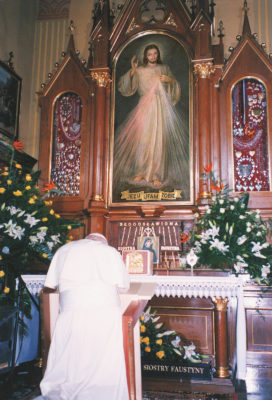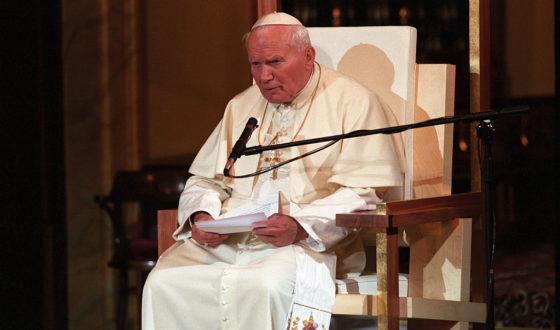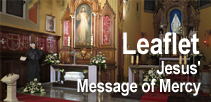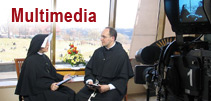“The Message of Divine Mercy has always been near and dear to me. It is as if history had inscribed it in the tragic experience of the Second World War. In those difficult years it was a particular support and an inexhaustible source of hope, not only for the people of Krakow but for the entire nation. This was also my personal experience, which I took with me to the See of Peter and which in a sense forms the image of this Pontificate.” – these words uttered by Pope John Paul II at the Shrine of Divine Mercy in Krakow-Łagiewniki are key to the understanding of his life, teaching and apostolic ministry. Inspired by the message of Divine Mercy, which God revealed through Sister Faustina, John Paul II wrote the Encyclical, Dives in Misericordia, the first in the history of the Church to be devoted to Divine Mercy; introduced the feast of Divine Mercy into the Liturgy of the Church on the first Sunday after Easter; and entrusted the whole world to Divine Mercy, so that humanity could find in It salvation and the light of hope.
Then followed particular events that became ideal occasions for showing to the world the message of Mercy – the truth of which is revealed in the pages of the Old and New Testaments.
These were : the beatification and canonization of Sister Faustina; pilgrimages to the Shrine of Divine Mercy in Krakow-Łagiewniki; the subsequent turn of the century with great threats in the new millennium; not forgetting this Pope’s apostolic journeys and ordinary teaching, for example when offering the prayer Regina Caeli, Exploring the mystery of the merciful love of God for man led John Paul II to present evangelical models: trust in God and mercy toward our neighbour. John Paul II repeatedly called for Christians in our day to become apostles and witnesses of this truth of faith, because – as he stated – “There is nothing that man needs more than Divine Mercy – that love which is benevolent, which is compassionate, which raises man above his weakness to the infinite heights of the holiness of God.” The date of his death became a sign for the Church and for the world, as it occurred on Saturday, 2 April 2005, the Eve of the Feast of Mercy, a Feast already celebrated in the Church’s liturgy. It was as if, in this way too, the Holy Father had yet again pointed to what is most important for the Church and for the world. The road of hope passes through getting to know the mercy of God, entrusting everything to Him, and doing good to others.
“How greatly today’s world needs the mercy of God!” – said John Paul II in Łagiewniki in 2002 – “In every continent, from the depth of human suffering, a cry for mercy seems to rise up. Where hatred and the thirst for revenge dominate, where war brings suffering and death to the innocent, there the grace of mercy is needed in order to settle human minds and hearts and to bring about peace. Wherever respect for life and human dignity are lacking, there is need of God’s merciful love, in whose light we see the inexpressible value of every human being. Mercy is needed in order to ensure that every injustice in the world will come to an end in the splendour of truth. (…) In the mercy of God the world will find peace and mankind will find happiness!”
 “The mystery of God’s merciful love was the centre of the Pontificate of my venerable Predecessor.” – said the Holy Father Benedict XVI (Regina Caeli, II Sunday of Easter, 23 April 2006). It was manifested by Pope John Paul II not only in his teaching, but also in his lifestyle and apostolic ministry. At the very beginning of his pontificate, 30 November 1980, he issued the encyclical Dives in Misericordia, the first papal document of such magnitude in the history of the Church, and one wholly devoted to the mercy of God and of man. John Paul II confessed that he couldn’t do otherwise than write this encyclical, the reason being that he had discovered that the truth of the merciful love of God for man is the only light, hope and salvation for humanity and the world; a world which, while it boasts of the unprecedented achievements of civilization, nevertheless feels its existence to be threatened not only on a biological, but also on a spiritual level.
“The mystery of God’s merciful love was the centre of the Pontificate of my venerable Predecessor.” – said the Holy Father Benedict XVI (Regina Caeli, II Sunday of Easter, 23 April 2006). It was manifested by Pope John Paul II not only in his teaching, but also in his lifestyle and apostolic ministry. At the very beginning of his pontificate, 30 November 1980, he issued the encyclical Dives in Misericordia, the first papal document of such magnitude in the history of the Church, and one wholly devoted to the mercy of God and of man. John Paul II confessed that he couldn’t do otherwise than write this encyclical, the reason being that he had discovered that the truth of the merciful love of God for man is the only light, hope and salvation for humanity and the world; a world which, while it boasts of the unprecedented achievements of civilization, nevertheless feels its existence to be threatened not only on a biological, but also on a spiritual level.
In this encyclical the Holy Father recalled the revelation of the merciful love of God in the Old and New Testaments. He firstly appealed to the rich experience of mercy in the history of the Chosen People, especially in events such as the departure from Egypt; the covenant made on Sinai and the giving of the law of life, that is the Decalogue; the sojourn in the desert and journey to the Promised Land; and then the leading of the people, despite their infidelity and dissensions. Mercy was part of Israel’s communion with their God, especially in those moments when they suffered misery as a consequence of having broken the Covenant. The recognition of infidelity and sin, and the appeal to the mercy of God, obtained forgiveness for them and return to a life in covenant with God.
Jesus Christ referred to the Chosen People’s experience of mercy when He revealed the fullness of the mystery of the merciful love of God to man. In Christ, Son of the living God, in His life, miracles and teaching, and above all in his Passion, Death and Resurrection, the truth of the merciful love of God was most fully revealed. In revealing the mystery of Divine Mercy, John Paul II focused especially on human dignity, which he believed is the very essence of mercy. John Paul II gave us a profound analysis of the parable of the Prodigal Son: “the relationship of mercy is based on the common experience of that good which is man, on the common experience of the dignity that is proper to him. This common experience makes the prodigal son begin to see himself and his actions in their full truth” (DM 6).
The paschal mystery of Christ can be seen as the supreme revelation and realization of the mystery of the mercy of God. His Cross, “speaks and never ceases to speak of God the Father, who is absolutely faithful to His eternal love for man, since He ‘so loved the world’ – and therefore man in the world – that ‘he gave his only Son, that whoever believes in him should not perish but have eternal life.’ Believing in the crucified Son means ‘seeing the Father,’ means believing that love is present in the world and that this love is more powerful than any kind of evil in which individuals, humanity, or the world are involved. Believing in this love means believing in mercy.” (DM 7). The Holy Father devotes separate chapters in the encyclical to outlining “an image of our generation” and the mercy of God in the Church’s mission. John Paul II emphatically points out that the fundamental right, and at the same time, the duty of the Church – at every stage of its history and especially today, when the world is full of an unusual accumulation of evil – is to profess the mercy of God and proclaim it “in all its truth” (DM 13), to practice Mercy towards others (DM 14), and to appeal in prayer to the mercy of God, “according to the needs of man in the modern world” (DM 15).
There is an astonishing similarity between the papal encyclical Dives in Misericordia and the content of Sister Faustina’s Diary. One could say that the essential message of Mercy written by her in the Diary became the wording of the papal teaching on the merciful love of God for humanity and in human relationships. The same tasks that Jesus entrusted to Sister Faustina in her prophetic mission, the Holy Father John Paul II set for the whole Church. He noted that the profession and proclamation of the mystery of the mercy of God, practising mercy in human relationships, and imploring mercy for the world – are not only fundamental rights, but also duties of the Church.
The beatification and canonization of Sister Faustina
The beatification and canonization of Sister Faustina Kowalska was a special occasion for showing the world the mystery of the mercy of God. During the beatification in St. Peter’s Square in Rome, 18 April 1993, Pope John Paul II referred to the prophetic words of this Apostle of the Divine Mercy, saying that her mission will not really end with her death, but will then truly begin. The Pope said, “And it truly did! Her mission continues and is yielding astonishing fruit. It is truly marvellous how her devotion to the merciful Jesus is spreading in our contemporary world and gaining so many human hearts! This is doubtless a sign of the times — a sign of our twentieth century. The balance of this century, which is now ending, in addition to the advances which have often surpassed those of preceding eras, presents a deep restlessness and fear of the future. Where, if not in the Divine Mercy, can the world find refuge and the light of hope?”
Seven years later, in the Jubilee Year, 30 April 2000, the Holy Father John Paul II canonized Sister Faustina. In his homily, based on the liturgical readings of the first Sunday after Easter, he showed the merciful love of God in the event when the Risen Lord meets the disciples and gives them the authority to forgive sins. John Paul II said that “However, as the Apostles once did, today too humanity must welcome into the upper room of history the risen Christ, who shows the wounds of his Crucifixion and repeats: Peace be with you! Humanity must let itself be touched and pervaded by the Spirit given to it by the risen Christ. It is the Spirit who heals the wounds of the heart, pulls down the barriers that separate us from God and divide us from one another, and at the same time, restores the joy of the Father’s love and of fraternal unity.” Referring to the mission of Sister Faustina, the Pope passed the message of God’s mercy to the whole Church for the third millennium. “I pass it on to all people,” added the Pope, “ so that they will learn to know ever better the true face of God and the true face of their brethren.” In a prophetic way, he announced certain painful experiences which will happen in the coming years, but they will be illuminated – as he said – by the light of God’s mercy entrusted to the world through the charisma of Sister Faustina.
In the Łagiewniki Shrine
In the context of the papal teaching on the mercy of God and the apostolic ministry of the Holy Father John Paul II, it is not surprising that the Pope made two pilgrimages to the Shrine of Divine Mercy in Kraków-Łagiewniki. Already in 1985, he called the Shrine the capital, or centre and heart of the Divine Mercy devotion, as Saint Sister Faustina, the great apostle of Divine Mercy who handed over the prophetic message of Mercy to the world, lived and died in this convent.
Pope John Paul II’s first Papal Visit to the Shrine of Divine Mercy was on 7 June 1997 – as he confessed – “to take part in the unending hymn in honour of Divine Mercy”. The Holy Father visited the convent chapel with its miraculous image – source of graces bestowed by the Merciful Jesus – and honoured the relics of the then Blessed Sister Faustina. It was a private meeting, yet the words spoken by the Pope carry universal meaning. Four messages are particularly noteworthy. The first one was addressed to all people, and emphasized that mercy is the most important thing in the life of every man: “There is nothing that man needs more than Divine Mercy – that love which is benevolent, which is compassionate, which raises man above his weakness to the infinite heights of the holiness of God.” The second message concerned man’s personal encounter with the merciful God. The Holy Father said that anyone can make this pilgrimage to Łagiewniki, to “look at this picture of the Merciful Jesus, his Heart radiating grace, and hear in the depths of his own soul what Blessed Faustina heard: ‘Fear nothing. I am with you always’ (Diary, q. II). And if this person responds with a sincere heart: ‘Jesus, I trust in you!’ he will find comfort in all his anxieties and fears. In this dialogue of abandonment, there is established between man and Christ a special bond that sets love free.” The third topic is a personal thanksgiving of the Pope uttered before the image of Jesus Merciful for the beatification of Sister Faustina, for establishing the Feast of Divine Mercy for the Church in Poland and the confession that for him the message of mercy had always been near and dear, that he took it from there to the Holy See, and that it shapes the image of his pontificate. The last message was addressed to the Congregation of the Sisters of Our Lady of Mercy, where Sister Faustina received from Christ the mission to proclaim the message of Mercy to the world. The Holy Father showed the need for her charisma and encouraged the sisters to undertake it in communion with the Church in all its dimensions. The Pope said that “The people of today need your proclamation of mercy: they need your works of mercy and they need your prayer to obtain mercy. Do not neglect any of these dimensions of the apostolate.”
The second papal pilgrimage to Łagiewniki (17 August 2002) took place during the last pilgrimage of John Paul II to his homeland, its motto being “God rich in mercy”, thus the pilgrimage carried a lot of beautiful content about the mystery of God’s mercy, St. Faustina, and this great entrusting of the world to the mercy of God, spoken by the Pope unexpectedly, but to the great joy of all. In his homily the Holy Father noted the role of the Holy Spirit in highlighting the merciful love of God to man:
”It is the Holy Spirit, the Comforter and the Spirit of Truth, who guides us along the ways of Divine Mercy. By convincing the world ‘concerning sin and righteousness and judgement’ (Jn 16:8), he also makes known the fullness of salvation in Christ. This ‘convincing’ concerning sin is doubly related to the Cross of Christ. On the one hand, the Holy Spirit enables us, through Christ’s Cross, to acknowledge sin, every sin, in the full dimension of evil which it contains and inwardly conceals. On the other hand, the Holy Spirit permits us, again through the Christ’s Cross, to see sin in the light of the mysterium pietatis, that is, of the merciful and forgiving love of God (cf. Dominum et Vivificantem, 32). Consequently, this ‘convincing concerning sin’ also becomes a conviction that sin can be laid aside and that man can be restored to his dignity as a son beloved of God.”
The Pope’s words rang out very meaningfully, as he expressed the desire that “the message of God’s merciful love, proclaimed here [in Łagiewniki] through Saint Faustina, may be made known to all the peoples of the earth and fill their hearts with hope. May this message radiate from this place to our beloved homeland and throughout the world. May the binding promise of the Lord Jesus be fulfilled: from here there must go forth ‘the spark which will prepare the world for his final coming’ (cf. Diary, 1732). This spark needs to be lighted by the grace of God. This fire of mercy needs to be passed on to the world. In the mercy of God the world will find peace and mankind will find happiness!”
On 18 August 2002 the Holy Father once again entrusted to the Church on the Kraków Błonia Park the task of proclaiming to the world the message of merciful love of God to man. Once again, he emphasized that this is a task for the whole Church when he said that “it would appear that we today have been particularly called to proclaim this message before the world. We cannot neglect this mission, if God himself has called us to it through the testimony of Saint Faustina.” Also once again, John Paul II justified the need to proclaim the mystery of God’s mercy to the world. He stated that ”The hour has come to bring Christ’s message to everyone: to rulers and the oppressed, to those whose humanity and dignity seem lost in the mysterium iniquitatis. The hour has come when the message of Divine Mercy is able to fill hearts with hope and to become the spark of a new civilization: the civilization of love.”
In other statements
Also in other papal documents, in catechesis at General Audiences and at prayer during the Regina Caeli, especially on the first Sunday after Easter, the Holy Father Pope John Paul II spoke constantly of the Biblical truth of God’s mercy, the call for trust in Jesus; and the call for active love toward our neighbour. In the Apostolic Letter Novo Millennio Ineunte, published at the beginning of the third millennium, the Pope reflected on the need for contemplation of Christ’s face and shaping the imagination of mercy. Divine and human mercy sets the direction of the Church’s life and of every Christian in the third millennium of Faith. John Paul II showed that the devotion to Divine Mercy, which derives from the knowledge of the mystery of Divine Mercy, is – as Pope Benedict XVI stated – “not a secondary devotion but an integral dimension of Christian faith and prayer”.
Looking back at the pontificate of John Paul II, one can say that it was really shaped by the mystery of Divine and human mercy. The treasure discovered in his youth, the treasure that is the messages of Mercy by Sister Faustina, he carried to the world as priest, cardinal and pope, becoming its ‘echo and interpreter’. On this truth of faith, which focuses on the dignity rather than on the needs of every human being, he left a very insightful teaching and a personalistic model of practising mercy. The richness of his teaching and the example of his life, benefit not only the Church but also people of goodwill who want to build on earth the civilization of love.
Sr. M. Elżbieta Siepak ISMM
Translated by Orest Pawlak
















